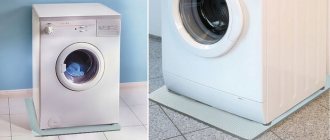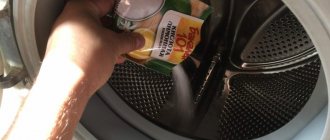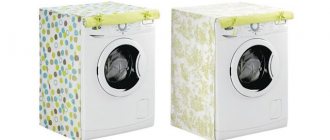A washing machine makes housekeeping much easier . But in order for the operation of equipment to bring only joy, it is necessary to take a responsible approach to its choice.
When purchasing, you should pay attention to the important characteristics of the models, on which their capabilities directly depend.
To choose a reliable and proven washing machine, we suggest that you familiarize yourself with the most popular models in terms of price and quality.
The table contains models that have received the highest reviews on the Yandex.Market service.
| Place | Model | Price |
| The most reliable in terms of price/quality ratio | ||
| #1 | LG F-1096SD3 | |
| #2 | Hotpoint-Ariston RSM 601 W | |
| #3 | Samsung WW65J42E0JW | |
| #4 | LG F1096SD3 | |
| Direct drive | ||
| #1 | LG Steam F2M5HS4W | |
| #2 | Weissgauff WMD 6160 D | |
| #3 | LG F-1096ND3 | |
| #4 | Bosch WAN 24260 | |
| With inverter motor | ||
| #1 | LG AI DD F4V5VS9B | |
| #2 | LG F-10B8MD | |
| #3 | Weissgauff WM 4927 DC Inverter | |
| #4 | Samsung WD70J5410AW | |
| Inexpensive models up to 15,000 rubles | ||
| #1 | Candy CS34 1052D1/2 | |
| #2 | ATLANT 40M102 | |
| #3 | Beko WRE 55P1 BWW | |
| #4 | Midea WMF-510E | |
| Premium segment from 60,000 rub. | ||
| #1 | Electrolux EW7WR368SR | |
| #2 | Bosch WDU 28590 | |
| #3 | LG AI DD TW4V9RW9W | |
| #4 | Bosch WAT 28541 | |
Page navigation:
Variations of washing machines
Conventionally, all washing machines are divided into 3 large groups:
- Not automatic (activator). The simplest and cheapest. They also have one significant advantage: they take up minimal space and are relatively lightweight. This may be important for those who do not have their own home and often change their place of residence. To transport such a washing machine you will not need to order specialized transport. Among the disadvantages: you need to do the spin yourself, as well as drain the water, rinse the drum (not rotating) from the remains of dirty water and detergent.
- Automatic with front loading. These are the most common ones today. These are the same washing machines that have a round hatch and a horizontally placed drum. Among the advantages: manufacturers focus on such washing machines. That’s why they have the widest functionality and all the innovations. They also have an even load distribution on the drum; they make less noise during operation or spinning.
- Automatic with vertical loading. In terms of functionality, as a rule, they are slightly inferior to the front ones. But they have one significant advantage - they take up less free space (due to their greater height).
About 85% of all buyers in 2021-2022 are considering purchasing only automatic washing machines.
They cost more but do most of the laundry work. Basically, all you need to do is load the laundry, add detergent, and when finished, hang the clothes out to dry.
Frontal
Their main advantage is a more uniform load on the drum as it rotates. And excess vibration is compensated with the help of a sinker installed on top, as well as shock absorbers located in the lower part of the drum.
Therefore, the impact on the body is minimal. And due to this, during operation they make minimal noise, even during spinning.
An additional advantage of front-facing washing machines is their attractive external design. It fits into almost any interior.
That is why in the CIS countries they can be placed both in the bathroom (for example, under the sink), and in the kitchen or even in the living room. This is only affected by where there is free space for installation.
Most of the production of modern concerns is also focused on front-loading washing machines. And therefore, all the newest and innovative functions can be found in such washing machines.
In others, they appear only after 3–5 years.
Another advantage of front-facing washing machines is the ability to produce them narrow in width.
Yes, this reduces the permissible load of clothes, but you can literally fit such a washing machine even in combined bathrooms (which are still found everywhere in the CIS).
Vertical
They occupy a smaller total area than the frontal ones. But it is impossible to make them narrow, since the drum must be balanced.
Additional advantages of such washing machines:
- They fail less often, since the design is a little simpler than the front ones. For example, they do not have a hatch or a lock sensor. There is also no need to install a sealing collar in front of the drum to prevent water from leaking out.
- More spacious for their size.
- Almost all top-loading washing machines have an ironing (drying) function. To do this, there is no need to place an additional heating element; it is enough to use the existing one and at this time rotate the drum at low speed.
REFERENCE! In washing machines with vertical loading of laundry, you will not be able to rotate the drum by hand due to the fact that its center of gravity is shifted downward. Therefore, it is blocked when the machine is turned off.
Built-in or freestanding
Front-loading washing machines are also divided into:
- Built-in.
- Freestanding.
Built-in
Installed directly into a designated niche. They allow you to save space and also install all equipment in a single overall design.
But in most cases such washing machines are more expensive. Also, to install them, you will need to seek help from third-party specialists.
And difficulties may arise when servicing them (for example, if you need to replace the drive belt or inlet valve).
They have only a front decorative insert (in the rear part, as a rule, there is only a sealed box and holding brackets for the pump, engine, shock absorbers).
Today, built-in washing machines are primarily used in commercial laundries (where the available space for placing equipment is limited).
Freestanding
The preferred option for most consumers.
Technically they differ from built-in ones only by the presence of a decorative casing. And they have a smaller drum size.
Narrow and full size
There are several typical sizes of front-loading washing machines:
- Standard. With a height of about 85 - 90 centimeters, depth - in the range from 45 to 60 centimeters. Allows you to load up to 6.5 kilograms of laundry.
- Narrow. The height is similar: about 85 - 90 centimeters. But the depth is up to 45 centimeters.
- Non-standard. We are talking about those washing machines whose dimensions differ from the above. Most manufacturers offer 2–3 such models.
We take into account energy consumption
Another important characteristic of automatic washing machines is power. It is usually designated by a letter, which is written on a sticker on the case and in its passport. The manufacturer calculates how much energy is spent on washing one kilogram of laundry at a temperature of 60 degrees.
The most economical class of washing machines is A+++, they consume up to 0.13 kWh. This is the most advantageous indicator at which the quality of washing clothes is not lost. Next come classes A++ and A+ with 0.15 and 0.17 kWh, A - up to 0.19 kWh and B - up to 0.23 kWh, which are also considered good indicators. Classes C (0.23–0.27), D (0.27–0.31), E (0.31–0.35) and F (0.35–0.39) are considered average. They are less economical than the previous ones.
To prevent the machine from overusing electricity, it is enough to follow three simple rules:
- Every time you wash, load the machine to the maximum - a half-empty drum wastes extra energy.
- Choose the right washing mode to avoid washing items longer than necessary.
- The water heater consumes the most energy: at a temperature of 95 degrees, the machine will consume more kWh than in the energy efficiency indicator, and at 30 - less.
Basic washing machine programs
The general set of washing programs for all washing machines is approximately the same:
- washing wool products;
- cotton;
- synthetics;
- prewash;
- quick wash;
- daily washing;
- intense;
- manual;
- delicate.
Washing wool products
It is performed in warm water, but as delicately as possible, and also with additional rinsing (to wash away any remaining detergent, since wool items act like a “sponge”).
Cotton
One of the most universal washing modes. Can also be used everyday.
Temperature - up to 95 degrees, spin - at maximum speed.
Takes, on average, 60 – 90 minutes. For comparison, washing wool takes up to 3 hours.
Synthetics
Synthetic items are wear-resistant, but cannot withstand high temperatures.
Therefore, the washing machine operates at maximum speed, but the water heats up to only 60 degrees.
Prewash
When you turn on this program, 2 consecutive washing cycles are launched, so it takes a really long time (3.5 - 4 hours).
It is recommended to use for clothes with the most stubborn stains, when it is impossible to get rid of them in the usual way.
You need to add a little more powder or gel to the detergent compartment than usual. During the washing process, it is fed gradually into the drum (in portions, not all at once).
Quick wash
The shortest program, suitable for washing lightly soiled items. Water heating is minimal - only up to 30 - 40 degrees.
After completion, the spin cycle is turned on at maximum speed. The entire cycle takes, on average, 45 – 70 minutes.
In some washing machines, the program may be referred to as “super-fast” or “express”. All this is the same algorithm.
Daily wash
This option is similar to a quick wash, but takes a little longer.
In some washing machines, it differs from the fast one only in the additional rinse and spin cycle to completely wash out the remaining detergent.
Intensive
Designed for very dirty items.
The speed during both washing and spinning is maximum. The temperature rises to 90 degrees, the consumption of detergent is high.
By default, many washing machines also include a cold water pre-soak program. Therefore, the entire cycle takes, on average, more than 2 hours.
Manual
This program is best suited for washing fabrics that require careful handling. For example, curtains, tulle, wedding dresses.
The speed is minimal, the temperature does not exceed 40 degrees, the detergent is used in portions, and an additional rinse is activated.
For many manufacturers, spinning is turned on by default either at the lowest speeds or not at all.
Delicate
It is analogous to manual. The key difference is the use of spin at normal speed (400 - 600).
Otherwise, the same temperature settings, the same number of drum rotation cycles.
Selecting the spin speed
In modern washing machines, spin speeds can reach 2000 rpm. The higher the speed, the more energy the machine consumes and the drier the laundry after finishing washing.
Each machine has its own spin class, it is designated by a letter and indicated in the technical specifications.
- "G" and "F" are the lowest grades. The maximum speed is 400 and 600 rpm, respectively, things remain almost completely wet.
- “E” - up to 800 revolutions, clothes dry by 25%.
- “D” - up to 1000 rpm, laundry is spun by 30%.
- “C” - up to 1200 revolutions, the laundry is half dry.
- “B” - up to 1400 rpm, 45% of moisture is removed from clothes.
- “A” - from 1600 to 2000 rpm, things dry almost completely.
To determine what spin speed you need, you will have to analyze what you are washing. For example, if your wardrobe is dominated by clothes and bedding made of cotton and natural fabrics, it is recommended to wash them at a spin speed of up to 1000 rpm. If you use things made of different materials, choose a machine with the ability to adjust the spin cycle.
Additional modes
Now manufacturers mainly compete with each other by adding new unique washing modes.
You can often find the following:
- ECO;
- wash in cold water;
- night;
- silk;
- for children's things;
- bio-care;
- removing stubborn stains;
- boiling;
- drying;
- additional rinse.
ECO
The key difference is the minimal power consumption.
Therefore, the washing cycle starts at a temperature of only 30 degrees and takes up to 40 - 60 minutes. Speed - minimum or medium (for spinning - too).
If you believe the statements of the manufacturers themselves, then this mode allows you to save about 30 - 40% of consumed electricity.
Wash in cold water
It is used for delicate fabrics that cannot be washed in water above 40 degrees, and there are no stains that are resistant to removal.
Night
Extended cycle, but always at low speed.
The main difference is the minimum noise emitted during operation.
Silk
Option for combined fabrics, which contain both natural and synthetic materials.
The temperature is average (up to 60 degrees), the speed is the same.
For children's things
Minimum detergent consumption, high temperature, several additional rinse cycles. Spin - at medium speed.
The result is a relatively gentle treatment of fabrics, but with the removal of stubborn stains, which are a common occurrence on children's clothing.
Biocare
Runs 2 independent wash cycles. The first one is at low temperature, the second one is at high temperature.
Suitable for heavily soiled clothing, while at the same time providing gentle care.
Removing stubborn stains
This mode involves pre-soaking in water at high temperature and using a small amount of detergent.
Allows you to get rid of those spots in which other modes were “powerless”.
Boiling
Maintain maximum temperature in water.
Best suited for washing bed linen and removing yellow stains.
Drying
After the washing is completed, the items are heated using a heating element.
Allows for faster drying, but uses more electricity (approximately 25%).
Extra rinse
At the end of the wash cycle, another rinse cycle starts, allowing you to wash out all traces of detergent from your clothes.
Recommended for use when washing woolen, thick, and children's clothes.
Additional useful features
The following functions in a washing machine may be really useful for many:
- Drum cleaning function.
- Control lock.
- Delay start (timer).
Cleaning the drum
Manufacturers from LG were among the first to add this function to their washing machines.
When you start this program, several cycles of quickly filling and draining water are performed alternately, along with rapid rotation of the drum. Allows you to wash all insoluble fractions: rust, sand, hair.
Before starting this program, it is recommended to first clean the filter (to prevent blockages).
As a rule, it is launched using a combination of the “Intensive” and “Extra Rinse” buttons (hold for 3 seconds or more).
Control lock
A useful function for cases where there are small children living in the house, who can accidentally stop the wash or start a forced drain or spin cycle.
Using key combinations, you can temporarily disable control of the buttons (until you press them again). As a rule, those keys are selected that cannot be pressed randomly.
Delay start (timer)
Many of the washing programs take 2 – 3 hours. And at the end of it, things must be hung manually.
What will happen if the clothes are in the drum for 5 - 6 hours? Due to excessive moisture inside the machine body, wear of the same belt or control unit may accelerate (oxide will begin to appear).
And for such cases, the delay start function is used. That is, a timer is set, after which the machine will automatically start washing in the user-specified mode.
You can turn on the washing machine, for example, before leaving for work. The wash will start at approximately 2 - 3 o'clock in the afternoon and upon returning home the cycle will be completed. All that remains is to hang things out.
Drive type
A drive is used to spin the drum when washing in a machine . It comes in only two types:
- Belt drive. It was also produced in Soviet-era cars. Today, as a rule, it is used in devices at the lower price level. The rotational energy is transmitted using a belt. Unreliable, may cause difficulties with repair in case of wear or malfunction.
- Direct drive. Relatively new development. LG was one of the first to produce such machines. The technology consists of combining the drum and the motor into an integral system, due to which there are no unnecessary moving elements, which means there is nothing to break. In addition, this system allows the machine to operate more quietly.
Do I need a clothes drying mode?
Drying clothes involves blowing hot air over clothes after the main wash cycle has completed.
As a rule, for this purpose an additional heating element is installed in washing machines.
Is this mode really necessary? Its main advantage is faster drying of clothes. Also, after machine drying, ironing clothes is easier.
But there are also quite a lot of disadvantages:
- Clothes may appear wrinkled after drying. This problem is especially common in older washing machines, where this mode was not yet fully developed.
- Suitable for heat-resistant materials only. But this is not synthetics, and cotton is not recommended for such treatment in all cases.
- Washer-dryers take up more space.
- Washing machines with drying mode are slightly more expensive.
There are no additional advantages to having this mode. But in expensive washing machines it is installed by default.
Which brand to choose a washing machine
If we focus directly on the reviews of consumers themselves, as well as technical experts, we can highlight the following most popular brands of washing machines:
- Samsung . Relatively inexpensive and reliable. Also, this manufacturer has the largest number of programs. Washing machines with heaters that have a ceramic coating that is resistant to scale formation were among the first to be put into mass production.
- LG . Recently, a smaller range of models has been supplied to the CIS. But one of the main advantages is the reliability of such technology. As a rule, washing machines from LG are guaranteed for up to 3 years, and for the heating element - up to 5 years. None of the other manufacturers can boast of such an “offer”.
- Bosch. Belongs to the mid-budget and expensive categories of home appliances. They have the most reliable engines and do not skimp on any parts. But difficulties often arise with the repair of such washing machines; getting spare parts can also be quite difficult.
- Electrolux. One of the best-selling washing machines in Eastern European countries (according to official statistics provided by the manufacturers themselves). It is quite possible that this is due to the location of the bulk of production capacity for washing machines in these countries. Among the advantages is low cost with a good set of functionality.
- Weissgauff. Not the most popular German brand, but it has been producing equipment for over 50 years. A distinctive feature is compliance with so-called “green standards”. That is, these washing machines consume a minimum of electricity and provide thorough rinsing from detergent residues.
Price categories
Based on cost, washing machines are divided into several categories:
- Budget - from 3 to 21 thousand rubles. Such devices are not made from the highest quality material, which negatively affects their service life. The models have a minimum of functions, but manufacturers do not forget about ease of use and attractive design. The average operating period is 4-5 years.
- Medium – from 21 to 49 thousand rubles. Such equipment can work for 7-9 years. The devices delight their owners with a significant selection of washing and spin programs, as well as additional options.
- Elite – from 49 to 245 thousand rubles. Premium units last 10-15 years or more. They are reliable and take maximum care of your laundry.
TOP 5 washing machines according to buyers
According to the ratings of most popular retailers and online stores, the following models of washing machines can be distinguished, which consumers rated as the best combination of price and quality:
- Samsung WF8590NLW9;
- LG F1096ND3;
- Bosch WGA242X4OE;
- Electrolux PerfectCare 600 EW6S4R06W;
- Weissgauff WM 40275 TD.
Samsung WF8590NLW9
The best-selling model based on the results of 2022 - 2022 from Samsung.
Standard sizes, load up to 6 kilograms.
There is a foam level control function, as well as several additional modes for delicate and quiet washing.
Additional features: ceramic heater, drum balancing sensor, quick-release top cover.
Among the disadvantages: sometimes it freezes, but after a reboot the washing starts in normal mode.
LG F1096ND3
There is intelligent control of the washing process, as well as a whole range of protective sensors and programs (locking controls, doors, diagnosing leaks).
Among the advantages: minimal noise during operation, there is a hose for draining water when cleaning the filter.
Among the shortcomings, buyers mention only the incorrect operation of the “Cancel mode” button - it does not work in all programs.
Bosch WGA242X4OE
Washing machine with increased dimensions (depth - 59 centimeters including protruding parts of the rear wall). Allows you to load up to 9 kilograms of laundry.
Has a high-power engine. Additional functions: foam control, intelligent wash, leakage protection and control lock.
Advantages: low noise during operation, copes well with very dirty things.
The disadvantages are noise when spinning at high speeds, and you often have to change the belt. But this is true for all washing machines with high-power motors.
Electrolux PerfectCare 600 EW6S4R06W
The key characteristic is energy consumption class A+++. These are just becoming available for mass sale in Europe.
There is intelligent washing control, balance control, and smooth spin speed control (reduced drum rotation speeds are also supported).
Among the disadvantages: scratches quickly appear on the body. Apparently, “eco-friendly” materials were used for painting. Therefore, such equipment will need to be handled with care.
Weissgauff WM 40275 TD
One of the most popular top loading washing machines. Energy consumption class - A+++.
The advantage is durability. If you believe the reviews, then during 5 years of active operation, only 3% of cases required service. And in most cases, this means replacing the belt or repairing the top door.
The disadvantage is that it is very noisy during operation.
In summary, when choosing a washing machine, it is recommended to focus on the consumer’s own needs. That is, take into account the available programs.
You should also calculate the required dimensions in advance. Now the standard is 4.5 - 5.2 kilograms.
Frontal ones are more preferable, but vertical ones are suitable for those rooms where it is important to keep every available square meter of space free.
Noise level
Nowadays, washing machine manufacturers are trying to provide users with complete acoustic comfort. The noise level in cars is affected by the motor: the inverter motor is considered the quietest.
How to choose a washing machine based on noise level? Refer to the technical specifications of the device. If you want quiet equipment, then pay attention to models with a noise level of up to 55 dB during operation and up to 80 dB in spin mode. This volume will not wake up a sleeping child and will not disturb you.
Haier washing machines with inverter motors are quiet and there is no vibration even in spin mode. The drums of direct drive machines have pads that ensure silent sliding of laundry during washing.











